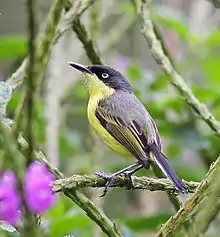Common tody-flycatcher
The common tody-flycatcher or black-fronted tody-flycatcher (Todirostrum cinereum) is a very small passerine bird in the tyrant flycatcher family. It breeds from southern Mexico to northwestern Peru, eastern Bolivia and southern, eastern and northeast Brazil.
| Common tody-flycatcher | |
|---|---|
 | |
| In Costa Rica | |
| Scientific classification | |
| Kingdom: | Animalia |
| Phylum: | Chordata |
| Class: | Aves |
| Order: | Passeriformes |
| Family: | Tyrannidae |
| Genus: | Todirostrum |
| Species: | T. cinereum |
| Binomial name | |
| Todirostrum cinereum (Linnaeus, 1766) | |
 | |
Taxonomy
The common tody-flycatcher was formally described by the Swedish naturalist Carl Linnaeus in 1766 in the twelfth edition of his Systema Naturae under the binomial name Todus cinereus.[2] Linnaeus based his description on the "Grey and Yellow Fly-catcher" that had been described and illustrated in 1760 by George Edwards from a specimen collected in Suriname.[3] The specific epithet cinereum is from Latin cinereus meaning "ash-grey".[4] The common tody-flycatcher is now the type species of the genus Todirostrum that was introduced by René Lesson in 1831.[5][6][7]
Eight subspecies are recognised:[7]
- Todirostrum cinereum virididorsale Parkes, 1976 – Veracruz and Oaxaca (south Mexico)
- Todirostrum cinereum finitimum Bangs, 1904 – Chiapas and Tabasco (south Mexico) to northwest Costa Rica
- Todirostrum cinereum wetmorei Parkes, 1976 – central Costa Rica and Panama
- Todirostrum cinereum sclateri (Cabanis & Heine, 1860) – southwest Colombia, west Ecuador and northwest Peru
- Todirostrum cinereum cinereum (Linnaeus, 1766) – Colombia, Venezuela, the Guianas and northeast Brazil
- Todirostrum cinereum. peruanum Zimmer, JT, 1930 – east Ecuador and east Peru
- Todirostrum cinereum coloreum Ridgway, 1906 – north Bolivia and north Paraguay to southeast Brazil and northeast Argentina
- Todirostrum cinereum cearae Cory, 1916 – east Brazil
Description
The common tody-flycatcher is a tiny, big-headed bird, 9.5–10.2 cm (3.7–4.0 in) long, weighing 6.5–6.8 g (0.23–0.24 oz), and with a long, flattened, straight black bill. The upper head is black, shading to dark grey on the nape and dark olive-green on the rest of the upperparts. The usually cocked tail is black with white tips, and the wings are blackish with two yellow wing bars and yellow edging to the feathers. The underparts are entirely yellow. Sexes are similar, but young birds have a greyer upper head, buff wing markings, and paler underparts.
Males of this species have a rapid grasshopper-like ticking te’e’e’e’e’e’t call something like a tropical kingbird, and a dawn song consisting of a very fast high tic repeated up to 110 times a minute for minutes on end.
Distribution and habitat
It is a very common inhabitant in gardens, shady plantations, second growth and the edges and clearings of forest, although it avoids the dense interior of mature woodland and also arid areas. The common tody-flycatcher is usually seen in pairs, making rapid dashing sallies or hovering to pick small arthropods off the vegetation.[8] It often wags its tail as it moves sideways along branches.
Behaviour and ecology
Breeding
It breeds from sea level to 1,150 m (3,770 ft) altitude, locally to 1,500 m (4,900 ft). Both male and female birds build a pouch nest with a visored side entrance, which is usually suspended from a thin branch or vine 1–5 m (3.3–16.4 ft) high in a tree, though occasionally it can go up to 30 m (98 ft). The female incubates the two usually unspotted white eggs for the 15–16 days prior to hatching.
References
- BirdLife International (2012). "Todirostrum cinereum". IUCN Red List of Threatened Species. 2012. Retrieved 26 November 2013.CS1 maint: ref=harv (link)
- Linnaeus, Carl (1766). Systema naturae : per regna tria natura, secundum classes, ordines, genera, species, cum characteribus, differentiis, synonymis, locis (in Latin). Volume 1, Part 1 (12th ed.). Holmiae (Stockholm): Laurentii Salvii. p. 178.
- Edwards, George (1760). Gleanings of Natural History, exhibiting figures of quadrupeds, birds, insects, plants &c... (in English and French). Part 2. London: Printed for the author, at the College of Physicians. pp. 110–112, Plate 262.
- Jobling, James A. (2010). The Helm Dictionary of Scientific Bird Names. London: Christopher Helm. p. 108. ISBN 978-1-4081-2501-4.
- Lesson, René (1831). Traité d'Ornithologie, ou Tableau Méthodique (in French). Paris: F.G. Levrault. p. 384 (livraison 5).
- Traylor, Melvin A. Jr, ed. (1979). Check-List of Birds of the World. Volume 8. Cambridge, Massachusetts: Museum of Comparative Zoology. p. 87.
- Gill, Frank; Donsker, David; Rasmussen, Pamela, eds. (2020). "Tyrant flycatchers". IOC World Bird List Version 10.2. International Ornithologists' Union. Retrieved 29 November 2020.
- de A. Gabriel, Vagner; Pizo, Marco A. (2005). "Foraging behavior of tyrant flycatchers (Aves, Tyrannidae) in Brazil" (PDF). Revista Brasileira de Zoologia. 22 (4): 1072–1077. doi:10.1590/S0101-81752005000400036.
Further reading
- Skutch, Alexander F. (1960). "Black-fronted tody-flycatcher" (PDF). Life Histories of Central American Birds II. Pacific Coast Avifauna, Number 34. Berkeley, California: Cooper Ornithological Society. pp. 475–489.
Further reading
- Skutch, Alexander F. (1930). "The habits and nesting activities of the Northern Tody Flycatcher in Panama" (PDF). Auk. 47 (3): 313–322.
External links
| Wikimedia Commons has media related to Todirostrum cinereum. |
| Wikispecies has information related to Todirostrum cinereum. |
- "Common tody-flycatcher media". Internet Bird Collection.
- Common tody-flycatcher photo gallery at VIREO (Drexel University)
- Common tody-flycatcher species account at Neotropical Birds (Cornell Lab of Ornithology)
- Interactive range map of Todirostrum cinereum at IUCN Red List maps
- Audio recordings of Common tody-flycatcher on Xeno-canto.

.JPG.webp)